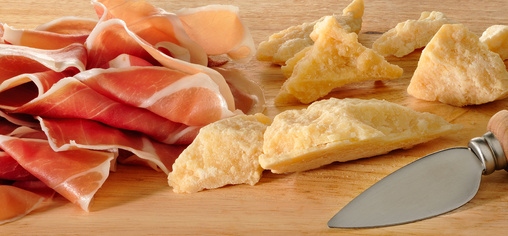Slow food
Date published: 19 October 2013

Parma Ham - prosciutto de parma
A few years ago I was fortunate enough to go on a buying trip to Italy.
From Bergamo airport just outside of Milan I planned a three day assault that would take me through Emilia Romagna, Lombardy and Piedmont regions. My goal was to take home Parma ham (prosciutto de parma), Parmesan cheese, balsamic di Modena and plenty of wine.
During the next three days I discovered a world of family owned business who still used time served traditions to painstakingly make their creations using the same techniques as their forefathers.
Two hour drive from Milan brought us go Langhirano in the Parma region. The location of this meat curing district is very well placed. There is a story about a group of hunters from Aquitania around 5 AD who shot a pig only to find it weeks later dried out from the sea air and sweeter tasting.
These hams must be reared and raised according to strict guidelines on approved farms in 10 regions of northern and central Italy. When they are brought in they are inspected and some immediately rejected as not up to standard.
Each ham is carefully massaged with salt, eliminating water and promoting maturing by concentrating and enhancing flavours then left to hang in a room set to the perfect temperature and humidity. During this week the moisture in the ham is brought out and it's colour begins to darken.
The salt is then removed and re-applied again and the process is repeated. To ensure that the depth of flavours and sweetness are brought on without over salting is a skill that only the maestro salatore is responsible for.
The hams are then hung for seventy days, washed thoroughly and a layer of pork fat is covered on the open leg muscle and moved to a secondary room. This is designed to recreate the open windowed houses where the hams would hang years ago allowing for the winds from the hills, through the chestnut trees to envelop the hams daily.
Only in this precise area with its unique breeze and temperature will the ham continue to develop its flavours. They will remain here for up to thirty months. During this time they will have lost as much as thirty percent in weight leaving the finished hams weighing eight to ten kilo.
It's a labour of love and that's why it's so expensive but tastes so good.
My recommendation. Get yourself some italian cheese (Pecorino Sardo, Tallegio, Gorgonzola) and some Parma ham and serve with a well chilled bottle of Prosecco.
Buon appetito
Food & Wine by Paul Sheerin
Pshearse@gmail.com
Do you have a story for us?
Let us know by emailing news@rochdaleonline.co.uk
All contact will be treated in confidence.
Most Viewed News Stories
- 1Man jailed for five years and three months after large scale drug dealing during Covid lockdown
- 2The estate overrun by cars that may soon be changed for the better
- 3Protestors attempt to ‘storm’ Andy Burnham HQ to demand chat with mayor
- 4Plan your perfect day at Rochdale Wedding Show
- 5College’s inaugural Apprenticeships Awards celebrate businesses and their rising star apprentices
To contact the Rochdale Online news desk, email news@rochdaleonline.co.uk or visit our news submission page.
To get the latest news on your desktop or mobile, follow Rochdale Online on Twitter and Facebook.

